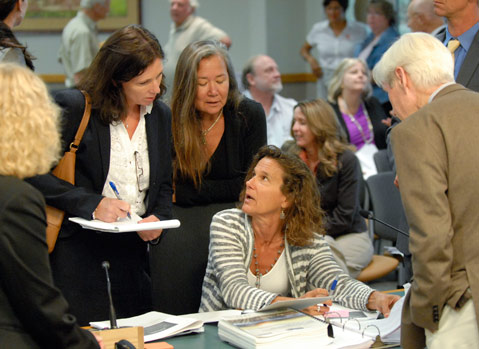County Moves Forward with First Big Solar Project
40-Megawatt System in Cuyama Would Power 15,000 Homes

Pointing northward to what will be a record-size solar farm in San Luis Obispo County, backward to a wind-turbine operation once planned for Lompoc, and forward to what many hope will be a more renewable-energy-rich future, the Santa Barbara County Planning Commission voted unanimously Tuesday in favor of a 40-megawatt solar array system in Cuyama. (A megawatt is a million watts.)
Pitched by photovoltaic behemoth First Solar, the project’s fate will rest in the hands of the Board of Supervisors, likely to examine the proposal in the fall. Pending the board’s okay — many speculated it was all but certain — and its full realization, the First Solar project would go above and beyond its name, becoming the county’s first major foray into alternative energy production.
While many celebrated the commission’s baton-pass — most of the public speakers supported it, and the holdouts half-heartedly opposed it — they did so knowing that the county won’t be seeing fields upon fields of solar panels in the future. Although Tuesday’s decision also included changes to streamline processing of future projects, transmission-line capacity in the Cuyama Valley would max out at 75 megawatts, and upgrades would cost tens of millions of dollars.
When the project gets up and running, that would allow for only one other 35-megawatt farm or multiple smaller-scale projects. And the Cuyama Valley, with rampant sunshine and flatter topography, is the region in the county most suited for large-scale solar projects and least likely to attract opposition from environmental groups.
To be located across 300-plus acres southeast of Cuyama, First Solar’s project — proposed in 2010 — would provide enough electricity to power 15,000 homes and displace 30,000 metric tons of carbon dioxide every year, or the equivalent of taking more than 6,000 cars off the road. Farming giant Bolthouse Properties owns the land — mainly for harvesting water-intensive baby carrots — but has agreed to give up a chunk of the property for the project, removing the parcel from its Williamson Act contract.
That change has stirred some alarm about setting precedents — Williamson affords tax breaks for land that is used for farming and preserved from development — but the county’s plans would allow the land to resume agricultural operations if the project ends after the panels’ 30-year-lifespan. The county will also receive increased property-tax revenues with the contract’s cancellation.
The panels, which will come with a 19,600-square-foot switchyard near the Pacific Gas and Electric Company’s (PG&E) substation, will move east to west with the sun during the day, feeding their energy into PG&E’s grid, with the nearby grid receiving the initial benefit. First Solar won’t need to use any water for its operations, save for a twice-yearly rinsing of the panels for dust removal.
Cuyama residents, farmers, electrical workers, and environmentalists all voiced their support on Tuesday, with many praising First Solar by playing on its name, calling it “first class” for its public outreach and donations to Cuyama causes. Many touted the jobs the facility would bring — 200 for construction, plus a handful for permanent maintenance positions — and highlighted the company’s proclivity for regional hiring.
Many farmers expressed relief over the land’s transfer from water-reliant row crops to solar panels and said the electricity generated from the panels could help reduce all-too-common brownouts. Several environmental activists noted the juxtaposition of this project and Measure P, the November ballot measure that would ban all new hydraulic fracturing, acidizing, and cyclic-steaming operations in the county. “Global warming is upon us, and this is our way of dealing with it,” said Commissioner Joan Hartmann. “I’m glad that First Solar is helping the county move forward.”
Supporters had a clear — and near — example to point to when detailing the project’s benefits. Currently in construction in San Luis Obispo County is First Solar’s Topaz project, which will provide 550 megawatts of electricity — enough to juice 160,000 homes — and is vying, along with another First Solar project in Riverside County, to be the largest solar farm in the world. First Solar’s total operations (including an array in Australia that powers a desalination plant) account for 8 gigawatts of energy worldwide. (A gigawatt is a billion watts.)
Tuesday’s vote came more than a year after Acciona, the company behind the Lompoc wind farm, officially backed out of those plans. The supervisors had approved the 60-turbine project in 2009, but the company then endured legal challenges from concerned neighbors. Jefferson Litten of the Community Environmental Council urged the commissioners to not let the perfect be the enemy of the good. “There’s no such thing as a perfect energy project,” he said, “but this project is very close.”



